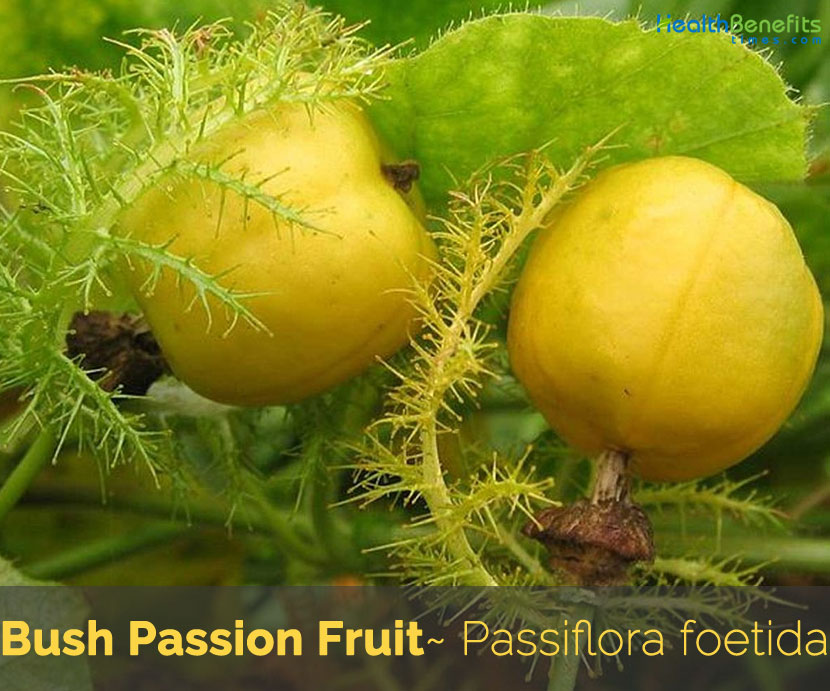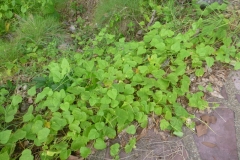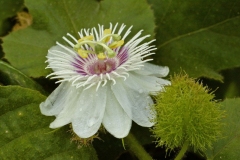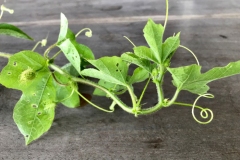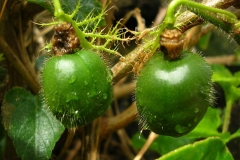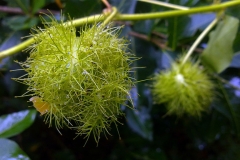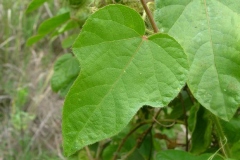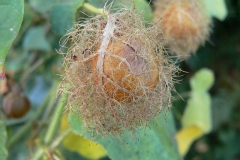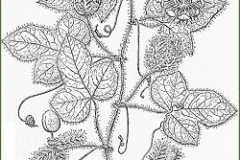The name of the genus is the combination of the Latin terms “passio, -onis” which means passion and “flos, -oris” which means flower with reference to the structure of the flower where the first Spanish missionaries did see the instruments of the Passion of Christ. The specific epithet, foetida, means “stinking” in Latin and refers to the strong aroma emitted by damaged foliage. Passiflora foetida is able to trap insects on its bracts, which exude a sticky substance that also contains digestive enzymes. This minimizes predation on young flowers and fruits. Whether or not it gains nourishment from its prey is uncertain, and it is currently considered a proto-carnivorous plant.
Plant Description
Bush Passion Fruit is an ill-scented, branched, climbing herbaceous annual or perennial plant that grows about 1.5 to 6 m tall. The plant is found growing in seashores, river banks, bush land, highway borders, wastelands, disturbed areas, along roadsides, in coastal thickets, patches of forest, cane fields, crops, plantations, forest edges/gaps, savannahs, riparian zones, watercourses (i.e. riparian habitats), closed forests, coastal environs in tropical and sub-tropical regions, greenhouses and facultative upland. The plant can grows on a wide range of soils from peats through loams to sands, as well as on soils derived from corals and volcanic debris. The plant has annual or perennial woody tap root. This plant is also a widely grown perennial climber, and has been used in traditional medicine.
Stem
The stems grow 1.5 to 6 m in height. It appears cylindrical in shape, thin, wiry and woody, covered with sticky yellow hairs on a total surface. They give off an unpleasant odor when crushed stems and leaves are suspected of poisoning livestock.
Leaves
Leaves most often have three rounded or pointed lobes, but sometimes they can be entire or five-lobed. These leaves are 3-10.5 cm long and 3-10 cm wide and are alternately arranged along the stems and borne on stalks 1-6 cm long. They are hairy on both surfaces, with the hairs along their margins often being sticky. At the base of each leaf stalk there is a tendril and a 1 cm long threadlike appendage (i.e. stipule) covered in sticky glands. It produces a pungent smell on crushing.
Flower
Flowers are 3-5 cm across vary from pinkish to white or purplish in color and are borne singly in the leaf forks on stalks 2-4.5 cm long. They are surrounded by three deeply-divided bracts 2-4 cm long that are densely covered in large sticky hairs. Each flower has five sepals 1-2 cm long and five petals 1-2 cm long. They also have five stamens, with anthers 4-5 mm long, and an ovary topped with three styles tipped with prominent stigmas. Flowering occurs mainly during autumn, winter and spring (i.e. from February to November). It flowers all year round, opening to the morning and closing before noon.
Fruit
Fertile flowers are followed by smooth globose berries that are 2-3 cm diameter partially enclosed by the persistent, deeply-divided, sticky bracts. Fruits are kumquat sized and contain a bluish- white pulp that is mildly sweet and delicately flavored. These fruit are somewhat hairy and turn from green to yellow or orange in color as they mature. Fruits are eaten by birds, who disperse the seeds.
Young fruit is cyanogenic and also eaten by Villagers. The bracts of this plant serve as insect traps, which exude a sticky substance that also contains digestive enzymes. This minimizes predation on young flowers and fruits, but it is as yet unknown whether the plant digests and gain’s nourishment from the trapped insects, or if it merely uses the bracts as a defensive mechanism to protect its flowers and fruit. This is still an issue of debate, and it is considered as proto-carnivorous plant.
Seeds
Seeds of Passiflora genus vary greatly in size and shape. However, several common features are apparent, including hard seed coats surrounding a white, well-developed, straight embryo, with large flat cotyledons. The thin layer of ruminated endosperm surrounds the embryo. Seeds are flat, black, woody and enclosed in sweet to aromatic pulp. The outer integument is 3-layered in Passiflora, but the inner is 3-layered in both. Seeds are covered with a succulent colored aril which originates as a small outgrowth around the funiculus at the organized embryo sack stage. The seed coat is formed by both the integuments is 6-layered in P. caerulea and P. edulis.
Health benefits of Bush Passion Fruit
Some of the benefits of the stinking passion fruit are listed below:
1. Maintain healthy bones
Stinking passion fruit consists of high content of calcium that is useful for maintaining healthy bones. Healthy bones are useful for maintaining bone density so as to avoid the risk of the exposed to osteoporosis. Stinking passion flower is called the fruit to cure the bone, because it can nourish your bones.
2. Prevent Anemia
Stinking passion fruit consists of good amount of iron that helps to produce red blood cells so as to prevent and overcome disease anemia.
3. Prevent Cancer
Stinking passion fruit has antioxidant substances consisting of the vitamin C, flavonoids and also potassium. The contents have the ability to counteract the effects of free radicals, such as the growth of cancer cells, as well as damaging skin tissue.
4. Controlling your blood pressure
The stinking passion fruit is very nice and helpful for the health of the body, because it can control blood pressure in order to remain stable.
5. Maintaining healthy gums and teeth
The stinking passion fruit is not only beneficial for the health of your bones. However the content of calcium in the fruit is also able to maintain the health of your gums and teeth.
6. Can overcome the Kidney Disorder
Mineral content in the fruit is also able to help kidney function in the process of excretion of urine.
Traditional uses and benefits of Bush Passion Fruit
- Leaves are used to treat asthma and hysteria.
- It is a medicinal plant used to treat diseases affecting women in Costa Rica.
- Leaves are used in baths for skin affections.
- Roots have antispasmodic properties and the flowers have beneficial effects for breast illnesses.
- Dry leaf is used as tea in Vietnamese folk medicine to relieve sleeping problems, as well as treatment for itching and coughs.
- Fresh, whole plant is boiled and the liquid used as a children’s anthelmintic, for intestinal nematodes and flatworms.
- Decoction of the dried plant is drunk to treat colds and chest coughs.
- It is also used in the treatment of tuberculosis, worms, and for coughs and colds.
- Fluid, pressed from the leaves and stem, is used to improve fertility in women.
- The root is antispasmodic.
- Leaves are crushed in water and the solution drunk as an antidote to the bite of the Papuan Black Snake.
- Leaves, combined with those of Erythrina variegata, are mashed and their juice extracted then drunk in order to induce sleep or to treat sleeping disorders.
- An infusion of the leaves is used for healing wounds.
- Fresh young leaves are mashed and then rubbed on to the wound of a snake bite.
- Leaf contains substances that have possible antimicrobial activity.
- Plants are used for itchy conditions.
- Decoction of fruit is used for asthma and biliousness.
- Decoction of leaves and roots are used as emmenogogue.
- Fruit are used as emetic.
- Leaves are applied to the head for headaches and giddiness.
- In India, traditionally used for diarrhea, throat and ear infections, liver disorders, tumors, itches, fever and skin diseases and for wound dressing.
- It is used for treatment of asthma in Malaysia.
- It is used to treat epilepsy in Argentina.
- It is used for gas, colds, and pregnancy to keep the baby active in Africa.
- Decoction of leaf and bark mixed with the same of Annona glabra as anthelmintic for flatworms and nematodes in French Guiana.
- Decoction of fresh whole plant drunk as children’s anthelmintic, for intestinal nematodes and flatworms.
- Decoction of dried plant used for colds and chest colds.
- It used for treatment of tuberculosis, worms, coughs and colds in NW Guyana.
- It is used as lotion or poultice for erysipelas and skin diseases with inflammation in Brazil.
- Leaves of the plant utilized as folk medicine for treatment of anti-anxiety, stress and insomnia.
- Hysteria can be cured by consumption of leaves and root decoction of P. foetida.
- foetida is used as or poultices for erysipelas and skin diseases with inflammation in countries like Brazil.
- This species can be helpful in treating digestive problems, including dyspepsia and diarrhea; alternatively, it used as an astringent and expectorant for nervous conditions and spasms.
- It is used in the treatment of itchy skin conditions such as scabies and tinea.
- Leaves are crushed and soaked in water to make a liquid application to relieve the itch.
- Rough sandpaper-like dry leaves are rubbed on the skin for tineaform skin infections such as ringworm.
- Leaf paste of Passiflora foetida is applied for headache and to treat skin diseases.
- In Brazil they are used in the form of lotions against skin diseases.
Other Facts
- In parts of Malaysia, it is a serious weed of maize and rubber.
- It also impacts negatively on coconut production in the Pacific; on maize, sugarcane and cotton in Thailand; on oil palm in Indonesia; on taro in Samoa; and on various other crops in Sarawak.
- Common diseases in chickens are treated with different preparations of the fruits, leaves, stem and seeds, given orally or topically, in Ogun State, Nigeria.
- Plant is used as a ground cover and as a hedge.
Prevention and Control
Due to the variable regulations around (de)registration of pesticides, your national list of registered pesticides or relevant authority should be consulted to determine which products are legally allowed for use in your country when considering chemical control. Pesticides should always be used in a lawful manner, consistent with the product’s label.
Cultural Control
P. foetida may best be controlled by uprooting, either directly, or during inter row cultivation and interplant hoeing. It cannot be smothered out, since it tolerates low light intensities and also tends to climb over taller plants. Good field hygiene is important in minimizing the spread and proliferation of the weed; plants should be controlled by whatever means available before they flower and set seed. Composting material should be free of dormant weed seeds.
Grazing is unlikely to be effective due to the objectionable smell (and no doubt taste) of bruised foliage.
Chemical Control
Chemical control is only worthwhile in graminaceous crops such as sugarcane or improved pastures, or where the herbicide can be directed away from crop foliage, since foliar application to broad-leaved crops would damage them. Henty and Pritchard (1975) and Kostermans et al. (1987) report that picloram, asulam and ametryne may give shoot kill only in sugarcane in Queensland, Australia, and that amitrole can be used as a directed spray in rubber. Webb and Feez (1987) report that fluroxypyr gives excellent selective control of P. foetida in both sugarcane and sorghum.
Biological Control
No attempts have been made at biological control of P. foetida in the field. Some work has been conducted, however, to establish the potential for biological control of the Pasifloraceae. Gardner showed that a number of weedy Passiflora spp. were vulnerable to vascular wilt caused by Fusarium oxysporum f.sp. Passiflora while the cultivated species P. edulis f. flavicarpa was not. Waage et al. (1981) examined the host ranges of a number of heliconius butterflies with a view to their potential for biological control. Chavez et al. (1999) successfully transmitted viral pathogens of Passiflora edulis to P. foetida by grafting, mechanical inoculation, and the aphid Aphis gossypii and the chrysomelid beetles Diabrotica sp., Cerotoma sp. and Colaspis sp. However, aphid resistance in the field seems high due the sticky hairs, as well as against other insects less than 2 mm.
References:
https://www.itis.gov/servlet/SingleRpt/SingleRpt?search_topic=TSN&search_value=22225#null
http://www.hear.org/pier/species/passiflora_foetida.htm
https://www.cabi.org/isc/datasheet/38800
https://plants.usda.gov/core/profile?symbol=PAFO2
https://npgsweb.ars-grin.gov/gringlobal/taxonomydetail.aspx?26968
http://www.theplantlist.org/tpl/record/kew-2559676
https://en.wikipedia.org/wiki/Passiflora_foetida
https://www.wildflower.org/plants/result.php?id_plant=pafo2
https://keyserver.lucidcentral.org/weeds/data/media/Html/passiflora_foetida.htm
https://bie.ala.org.au/species/http://id.biodiversity.org.au/node/apni/2890763#overview
http://luirig.altervista.org/schedenam/fnam.php?taxon=Passiflora+foetida
https://indiabiodiversity.org/species/show/266676
https://gd.eppo.int/taxon/PAQFO
http://tropical.theferns.info/viewtropical.php?id=Passiflora+foetida
http://www.stuartxchange.org/Prutas-baguio.html
http://citeseerx.ist.psu.edu/viewdoc/download?doi=10.1.1.447.2983&rep=rep1&type=pdf
https://www.aidic.it/cet/18/64/041.pdf
http://www.iucngisd.org/gisd/species.php?sc=341
http://www.flowersofindia.net/catalog/slides/Love%20in%20a%20Mist.html
http://issg.org/database/species/ecology.asp?si=341&fr=1&sts=&lang=EN
https://cnas-re.uog.edu/guam-weeds/passiflora-foetida/
Comments
| Bush Passion Fruit Quick Facts | |
|---|---|
| Name: | Bush Passion Fruit |
| Scientific Name: | Passiflora foetida |
| Origin | Southern USA (i.e. Texas and southern Arizona), Mexico, Central America (i.e. Belize, Costa Rica, El Salvador, Guatemala, Honduras, Nicaragua and Panama), the Caribbean and South America |
| Colors | Green when young turning to yellow or orange to red |
| Shapes | Oval, 2-3 cm diameter, smooth, partially enclosed by the persistent, deeply-divided, sticky floral bracts |
| Flesh colors | Bluish-white |
| Taste | Mildly sweet and delicately flavored |
| Health benefits | Maintain healthy bones, Prevent Anemia, Prevent Cancer, Control blood pressure, Maintain healthy gums and teeth, overcome the Kidney Disorder |
| Name | Bush Passion Fruit |
|---|---|
| Scientific Name | Passiflora foetida |
| Native | Southern USA (i.e. Texas and southern Arizona), Mexico, Central America (i.e. Belize, Costa Rica, El Salvador, Guatemala, Honduras, Nicaragua and Panama), the Caribbean and South America (i.e. French Guiana, Guyana, Surinam, Venezuela, Brazil, Bolivia, Colombia, Ecuador, Peru, Argentina, Chile, Paraguay and Uruguay). It has also been widely naturalized in other tropical regions of the world including south-eastern Asia |
| Common Names | Running pop, Stinking passionflower, fetid passionflower, scarletfruit passionflower, Galapagos passionflower, Love–in-the-mist, Scarletfruit passionflower, Fetid passionflower, red-fruit passionflower, running-pop, wild water-lemon, Love-in-a-mist passionflower, Mossy passionflower, Stinking granadilla, Stinking passionfruit, fit-weed, wild passionfruit, passionflower, pop vine, red fruit passionflower, stinking passion vine, stinking passionflower, wild passionfruit |
| Name in Other Languages | Assamese: Junuka phul, Lota bel, Koth bel, Koth-bel, Junuka-lata, Kotal-bel, Mewa Azerbaijani: Pisiyli qonaqotu Argentina: Ataco, corona de Cristo, granadilla, mburucuyá, mburucuyá aceitosa, mburucuyá menor, mburucuyá miní, mburucuyá rastrero, pasionaria, pasionaria hedionda, pocoto Australia: Mossy passion flower Bengali: Jhumka Lota (ঝুমকোলতা) Bolivia: Pedón Brazil: Maracajusinho (San Luis Island), maracujá catinga, maracujá de cheiro, maracujá de cobra, maracujá de estalo, maracujá de lagartinho, maracujá fedorento, maracuja-da-petra Cambodia: Sav mao prey Chamorro: Dulce, kinahulo‘ atdao Chinese: Long zhu guo (龙珠果),Ye xian guo, Long zhu cao, Long yan guo, Tian xian guo Colombia: Bejuco canastilla, chulupa de loma, cinco Ilagas, cocorilla, curubo, flor de la passion, gulupo Chuukese: Bombom Dominican Republic: Caguazo, mariballa Ecuador: Love in a mist El Salvador: Granadilla colorado, granadilla montes, sandia de culebra English: Running pop, Stinking passionflower, fetid passionflower, scarletfruit passionflower, Galapagos passionflower, Love–in-the-mist, Scarletfruit passionflower, Fetid passionflower, red-fruit passionflower, running-pop, wild water-lemon, Love-in-a-mist passionflower, Mossy passionflower, Stinking granadilla, Stinking passionfruit, fit-weed, wild passionfruit Fijian: Loliloli ni kalavo, poniu, qaranidila, sou, vaini, wild passion fruit French: Marie goujeat, Marie-Gougeat, passiflore, passiflore fétide, petite grenadille, poc-poc, poc-poc sauvage, toque molle German: Übelriechende Passionsblume, Galapagos-Passionsblume, Rotfrüchtige Passionsblume, Stinkende Grenadille Guadeloupe: Magouja, mariegougeat Guam: Kinahulo atadeo Guyana: Mis-mis, Semito, Simatoo Haitian: Marigouya, bonbon koulèv, toque molle Hawaiian: Lani wai, pohāpohā Hebrew: שעונית מבאישה Honduras: Granadilla I-Kiribati: Te biku India: Banchathail, mukkopeera, jhumka lata (झुमका लता) Indonesian: Rambusa prefer, Ciplukan rambat, buah tikus, ceplukan blunsun, katceprek, katjeprek, lemanas, permot, permot rajutan, rambaton blunsun Irula: Varingkodi – Ir Japanese: Kusa-tokeiso (クサトケイソウ) Jamaica: Granadilla, love in a mist, sweet cup Javanese: Jembut landa Kannada: Kukkiballi Kwara‘ae: Kakalifaka, kwalo kakali Madagascar: Tsipopoka Malay: Letup-letup, Gegambo Malayalam: Poochapalam, am’mūm’mappaḻaṁ (അമ്മൂമ്മപ്പഴം), Chirranchantiya Malaysia: Pokok lang bulu, timun dendang Manipuri: Lam radhikanachom (লম রাধিকানাচোম) Marathi: Vel-ghani (वेल घाणी) Mauritius: Poc-poc sauvage Mexico: Clavellín blanco, granadilla, jujito peludo, jujo Micronesia, Federated states of: Pwompwomw (Pohnpei) Myanmar: Suka, taw-suka-ban Nauruan: Oatamo, watamo Netherlands: Marie-goujeat Nicaragua: Catapanza Niuean: Vine vao Palauan: Kudamono Paraguay: Hóntayek, mburucuyá Persian: لیمو آب وحشی Peru: Bolsa mullaca, granadilla, granadilla cimarrona, puru-puru Philippines: Kurunggut, lupok-lupok, masaflora, melon meleonan, pasionariang-mabaho, prutas taungan Pohnpeian: Pompom, pwompwomw, pwomwpwomp Portuguese: Maraca jusinho, Maracuja catinga, Maracuja de cobra, Maracuja fedorento Puerto Rico: Flor de pasion sylvestre, Silvestre, tagua tagua Réunion: Petite grenadille, poc poc Russian: Strastotsvet vonyuchiy (Страстоцвет вонючий), passiflora izmenchivaya (пассифлора изменчивая), strastotsvet vonyuchiy (страстоцвет вонючий), strastotsvet izmenchivyy (страстоцвет изменчивый) Samoan: Pāsio vao, tapatapao Singapore: Timun dendang, timun hutan, timun padang Solomon Islands: Kakalifaka, kwalo kakali South Africa: Running pop Spanish: Bedoca, bejuco canastilla, bembillo, catapanza, cinco-llagas, granadilla, granadilla cimarrona, granadilla colorado, granadilla de culebra, granadilla montes, granadilla silvestre, injito colorado, parchita, pasiflora hedionda, pasionara hedionda, pedón, sandia de culebra, sandia de ratón, simito, vedoca, tumbillo, norbo cimarrón, caguajasa, clavellin blanco Sri Lanka: Dalbattu, kodimathulai, madahalu, udahalu Surinam: Snekimarkoesa Tamil: Kāṭṭuk koṭittōṭai (காட்டுக் கொடித்தோடை), Mosukkattan, Poonaipiduku, Siruppunaikkali, Chiru punai-k-kali, Mupparisavalli Telugu: Tellajumiki Thai: Ka-thok-rok (กะทกรก) Tongan: Vaine ‘ae kumā, vaine ‘initia USA/Hawaii: Scarlet fruited passion flower Venezuela: Cojón de gato, parchita de culebra, parchita de montana Vietnamese: Lạc tiên, chum bao Yapese: Tumatis, tutumis |
| Plant Growth Habit | Ill-scented, branched, climbing herbaceous annual or perennial plant |
| Growing Climates | Common on seashores, river banks, bushland, highway borders, wastelands, disturbed areas, along roadsides, in coastal thickets, patches of forest, canefields, crops, plantations, forest edges/gaps, savannahs, riparian zones, watercourses (i.e. riparian habitats), closed forests, coastal environs in tropical and sub-tropical regions, greenhouses and facultative upland |
| Soil | Grows on a wide range of soils from peats through loams to sands, as well as on soils derived from corals and volcanic debris |
| Plant Size | 1.5 to 6 m tall |
| Root | An annual or perennial woody tap root |
| Stem | 1-5 m long, cylindrical, branched, herbaceous, round and green. They are thin and wiry, covered with minute sticky yellow hairs. Older stems become woody |
| Leaf | Single, alternate, stipules to 1 cm long and divided into hair-like segments, petiole 2-10 cm long without nectary glands, blades 5-15 cm long, 3 or 5 lobed, the base cordate, the edges generally fringed with glandular hairs, the veins prominent, pale green and often finely hairy. It produces a pungent smell on crushing |
| Tendrils | Leaf-opposed, unbranched, coiling and grasping |
| Flowering season | July to September |
| Flower | Solitary in upper leaf axils, peduncle 3-5 cm long, bracts 2-4 cm long and deeply divided into hair-like segments that surround the flower and fruit, sepals 5, greenish petals 5, blunt, white to pale purple or pinkish, 3-5 cm across surrounding a 2-rowed corona of purplish filaments |
| Fruit Shape & Size | Oval, 2-3 cm diameter, smooth, partially enclosed by the persistent, deeply-divided, sticky floral bracts |
| Fruit Color | Green when young turning to yellow or orange to red, sometimes spotted, even pale green |
| Flesh Color | Bluish-white |
| Seed | Blackish, flattened, wedge-shaped, 3-4 mm long, irregularly ridged, surrounded by a transparent aril |
| Propagation | By seed |
| Taste | Mildly sweet and delicately flavored |
| Plant Parts Used | Whole plant, leaves, fruits, flower |
| Season | By seed |
| Health Benefits |
|
| Culinary Uses |
|
| Precautions |
|


